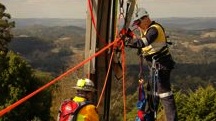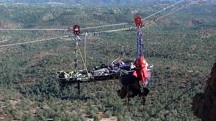The course begins abruptly with an impromptu field exercise to assess existing skill level within the "team". The course then explores all the available possibilities for setting up a horizontal, sloping or steep highline for removing, transporting or inserting rescuers or a patient including but not limited to:
1) Standard transportation-type highlines;
2) Drooping highlines;
3) Swiftwater highlines;
4) Reeving highlines (for varying trackline angles) and
5) Extreme highlines over 200m.
The main event of the seven day AIS seminar is an extreme highline of over 200m station-to-station high above the valley floor treetops!. The AIS also explores all aspects of advanced rigging including fall factors (ideal and practical), and reviews the belay drop test data more accurately than previous courses.
The AIS is rigging intensive! Advanced artificial high directionals like double gin poles ("V" frames), double "A" frames, and tripods for on or offloading the rescue package is common during the AIS. Other highline subjects covered include:
Single yoke and double yoke carriages
Passing bends on the tag lines
Tagline hangers for various highline applications
Tagline Prusik by-passes
High-strength trackline anchors-artificial and natural
Specialized Prusik minders
Setting trackline tension limits with and without a dynomometer
Single and two-carriage English Reeving highlines
Load bypasses on transecting obstructions
Limiting sag over rivers
Pilot line delivery systems-line throwers; tether balls; rockets;
messenger cord establishment and insertion
Highline logistics and tear down
Much, much more.



